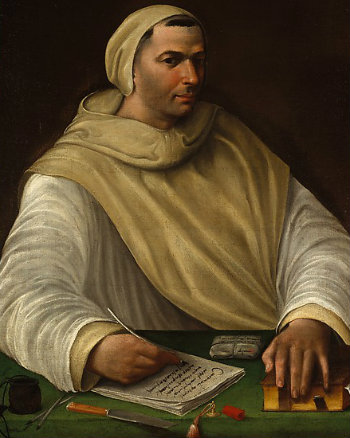The History of Art And The Curious Lives of Famous Painters
|
||||
|
Baldassare Tommaso Peruzzi was among the great architects of the Renaissance. Raised in Siena, Italy, Peruzzi arrived in Rome around 1503. In Rome he studied under Raphael. In 1525 he constructed the Ossoli palace in Rome. This building is considered one of the greatest architectural masterpieces of the Italian Renaissance. Peruzzi was also an active painter, collaborated with Raphael on numerous projects. His artwork primarily focused on mythological themes and reflects the Renaissance tenet of beauty with its inclination towards symmetry and geometric proportions. In terms of style, Peruzzi's work shows a slight influence of masters such as Michelangelo or Raphaelbut much more of a Sienese influence. His frescoes are rather lighthearted, fun and whimsical. During the Sack of Rome in 1527, many
of Peruzzi's works were destroyed in the looting and
pillaging. The artist was held hostage and later fled back to
Sienna where he designed a dam and tinkered with several inventions. He
later returned to Rome and continued working for the Republic as
architect and painter. |
||||
|
About The High Renaissance Period There is a spirit of general growth and enlightenment Artists of the Renaissance were elevated in social standing and their art was no longer looked upon as simple handicrafts, but as divinely inspired creations. The spirit of an era awoke, revitalized with knowledge and creativity. Although art still served a specific functions, which were primarily religious, painters added more of their individual spirit and personal vision to their creations. John Ruskin, famous art historian stated, "The art of any country is the exponent of its social and political virtues . The art, or general productive and formative energy, of any country, is an exact exponent of its ethical life. you can have noble art only from noble persons, associated under laws fitted to their time and circumstance." The major painters of the Renaissance were not only artists but men of great genius who gave the world their great intellectual gifts. Florentine and Venetian painting were both formed by extraordinary personalities. These independent creative geniuses tackled mathematical, artistic and philosophical problems of the highest interest, and presented solutions that have never lost their value. The greatest Renaissance master, Leonardo da Vinci declared "You will never have a greater or lesser dominion than that over yourself. . . . the height of a man's success is gauged by his self-mastery; the depth of his failure by his self-abandonment. . . . And this law is the expression of eternal justice. He who cannot establish dominion over himself will have no dominion over others." The sense of humanism pervading renaissance painting is still palpable. The painters touched on a multitude of issues regarding the human condition - death, love, reason, religion, universal morality, social problems. |
||||
|
Renaissance Art Techniques and Key Descriptive Words and Phrases associated with the Renaissance Movement - rebirth, rediscovery of the classical world, City-state, Humanism, Humanist, Francesco Petrarch, Reform, The Prince, Theocracy, The Inquisition, Human Reasoning, publication of Della Pittura, a book about the laws of mathematical perspective for artists, sfumato, chiaroscuro, linear perspective, Heliocentric Theory, vanishing point, Savonarola, spiritually significant, illuminated manuscript, idealized biblical themes, scriptorium, emotion, illuminator, Age of Discovery, axonometric drawing, curiosity about the natural world, mythology, realistic use of colours and light, Bonfire of the Vanities, Old Testament stories, ethereal and foggy backgrounds, Gospel parables, The Blackdeath, romanticized landscapes, Christian symbolism, Italian scholar Petrarch Require more facts and information about Renaissance art and the artists? Poke around every nook and cranny of the known universe for information this subject. Search Here © HistoryofPainters.com If you like this page and wish to share it, you are welcome to link to it, with our thanks. If you feel you have worthwhile information you would like to contribute we would love to hear from you. We collect essential biographical information and artist quotes from folks all over the globe and appreciate your participation. When submitting please, if possible, site the source and provide English translation. Email to millardmulch@gmail.com References - A History of Art for Beginners and Students: Painting, Sculpture, Architecture: Painting, by Clara Erskine Clement
|
